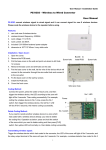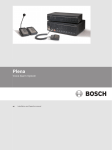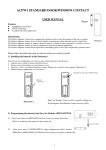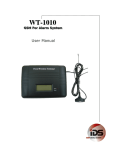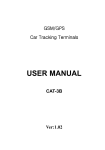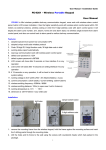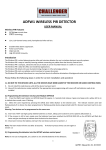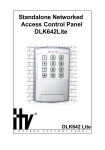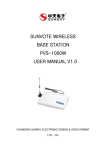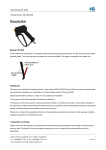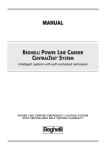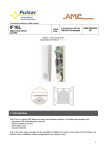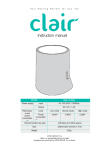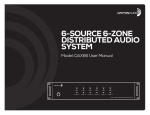Download WIRELESS PIR SENSOR
Transcript
WIRELESS PIR SENSOR USER MANUAL Wireless PIR Features EXTRA Low current draw. S.M.D. Technology. 12m, 110 Convex honey comb, hemispherical infra-red lens. Excellent false alarm suppression. Walk test LED. High RFI & EMI Immunity. ∘ Introduction The Wireless PIR is a dual-element passive infra-red intrusion detector for use in wireless electronic security systems. The Wireless PIR is easy to install by learning without connecting any cables from the Security Control Unit. The Wireless PIR is compact, attractive and easy to install, it can be mounted indoors on a wall or in a corner. The Wireless PIR is ideal for commercial, office and residential applications. The Wireless PIR detects intrusion by determining changes in infra-red energy patterns. The Wireless PIR emits no radiation and is harmless to humans & animals. The Wireless PIR reduces false alarms to a very low level due to its effective elimination of background noises and nuisance stimuli. Please follow the following steps in order to correctly install 1). Installing batteries in the detector Note: Do not use rechargeable, zinc carbon or zinc chloride batteries in the detectors. 1. Insert two “AAA” size alkaline batteries as shown, taking care to observe correct polarity (Illustration 1). Illustration 1 Note : The wireless PIR has a 2 minute warm-up period after it is powered up. 2). Programming the detector into your Wireless control unit system Press keys on Wireless control unit as follows: ** The User PIN code is factory set to 1234. ** (or different if you have setup your own unique PIN code) 1. 2. 3. Input user Pin <1> <2> <3> <4> and <Reset> button, while the CU is in standby mode. Press and hold the < Learn> button for over 5 seconds to enter Learn Mode with two beep sounds from CU. Hold the Detector at least 0.5m away from the CU. Within 10 seconds, trigger the Detector by moving your hand it front of the PIR lens. The CU will beep twice and the ‘Learn’ LED will turn ON. If no beeps are produced then the CU has reach its full capacity of PIR Detectors (4 max.) 4. Any Z1 to Z4 LEDs flashing indicates corresponding PIRs have been added. Z1 to Z4 LEDs OFF indicates corresponding PIRs are not yet programmed into these zones. The maximum capacity of the system is 4 wireless PIRs. If any further Detectors need to be added then trigger the next device within the 10 second learning period. If this period has expired then re enter learn mode. Programming order of the CU : Zone5 Zone6 Zone7 Zone8. If no more devices are added. all zone LEDs will turn off after 10 seconds and the CU will return to standby mode. 5. 6. 7. 1 Final Setup IMPORTANT – To extend the battery life, wireless PIR detectors are designed to detect once only before entering a “Sleep” condition for two minutes during which the unit will not trigger. Any movement seen by the PIR during this period causes “Sleep” condition to be extended by a further two minutes. Therefore, a wireless PIR which is constantly sensing movement, such as a person walking around a room, may appear to be non-functional; you will find that the PIR will detect normally again following a two minute period with no movement present. The wireless PIR detector contains one jumper, which activates/deactivates the LED. If required that the LED will be off when the detector is triggered during arm, pull this jumper off, otherwise, leave the jumper on. If you choose to leave the LED on, bear in mind that this will reduce battery life (Illustration 2). This LED is normally used only walk testing to ensure the PIR covers the detection area satisfactorily and then turned off. Illustration 2 3). Power OFF the CU Power OFF the CU completely after the Detector(s) have been learnt by isolating the backup power battery and mains power adaptor (to prevent the tamper function of the Detector(s) from triggering the alarm of the CU when mounting) 4). Mounting Location The PIR is designed for indoor use. It should not be mounted near to large metalobjects or on metal surfaces. It needs to be mounted on a wall or in a corner at a height of approximately 2-2.5meters for the best general coverage in an average room. The detector has been designed to avoid false alarms, nevertheless, it is best to avoid facing sources of heat such as fires and boilers, and always try to keep away from a window. A PIR can look at a radiator but should not be sited above one. Do not site a PIR where its field of view may be obstructed (e.g. by curtains). Also note that PIRs work best when sensing movement across rather than along their detection beams. Window Fire Boiler Radiator 2 Mounting the detector 1. 2. 3. 4. Remove and retain the screw from the bottom of the PIR and lift off the cover. (Illustration 3) If you are fitting the PIR in a corner, use mounting points ”A”, if you are fitting the detector on to a flat surface use mounting points “B” – the mounting points are shown by indentations in the plastic molding. Use a small drill to create two fixing holes at the mounting points (Illustration 4). Hold the base of the PIR in the chosen position, ensuring that the front of PIR will face towards the centre of the protected area, and mark and drill two 5mm fixing holes in the wall. DO NOT drill holes with the PIR in position – the resulting dust may damage the unit. Secure the PIR to the wall using two screws (25mm countersink) and the wall plugs. Replace the electronic module into the retaining clips, ensuring that it is correctly positioned and firmly seated. Install the battery into the battery snap. Replace PIR cover and refit retaining screw. Illustration 3 Illustration 4 5). Power the CU again Power up the CU again. The system will return to standby ready for use. Lens Arrays Specifications Type Housing Transmission range Transmission frequency Test LED Mounting Height Distance Range Dual Element low noise Pyroelectric sensor ABS 150 metres (open air with direct line of sight) 433MHz Selectable (on/off) 2-2.5 m Up to 12 meters Power Supply 3VDC (2 x 1.5V AAA Alkaline battery) (Batteries are excluded) Battery Life Approx. 18months 3



